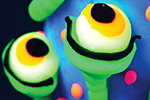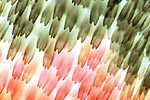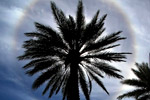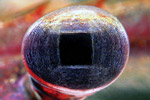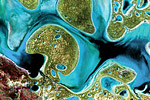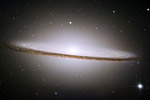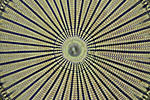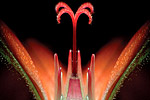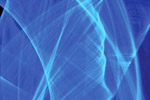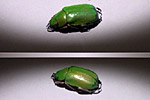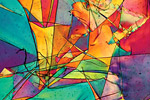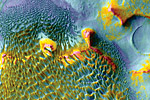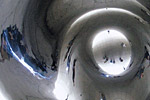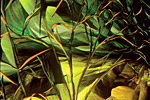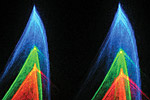Gallery
|
The Sun in three colors of ultraviolet light. Only active regions emit significant energetic ultraviolet light, so the colorful portions pinpoint the Sun’s hottest and most violent areas. The solar emission of visible light has been relatively stable over the past five billion years. |
|
This photo was taken through the infrared filter B+W IR093, which blocks visible light. Bright glow from sun-illuminated leaves and grass (Wood effect) is caused by strong reflection of IR light from plant cell walls. |
|
An object made from UV fluorescent plastics, which are often used for making glow sticks, signs and interior décor. The object is illuminated by ultraviolet light (also known as “dark light”) and emits light in the visible range. |
|
Close-up view of scales from a moth’s forewing, captured using Nomarski interference contrast illumination. |
|
This photo, third place winner in OPN’s 2006 After Image Photo Contest, shows an icy crown for a desert palm tree. The 22 degree halo is caused by reflection and refraction of sunlight in ice crystals making up cirrus clouds in the Arizona desert. |
|
Pupil of a Macrobrachium amazonicum (freshwater shrimp) magnified 20 times. |
|
Ephemeral Lake Carnegie in Western Australia fills with water only during periods of significant rainfall. In dry years it is reduced to a muddy marsh. This is a false-color composite image made using shortwave infrared, infrared and red wavelengths. The image has also been sharpened using the sensor’s panchromatic band. |
|
In May-June 2003, NASA’s Hubble Space Telescope captured the Sombrero galaxy, Messier 104 (M104). The galaxy’s hallmark is a brilliant white, bulbous core encircled by the thick dust lanes. As seen from Earth, the galaxy is tilted nearly edge-on. Here, it is viewed just six degrees north of its equatorial plane. M104 was nicknamed the Sombrero because of its resemblance to the Mexican hat. It is located 28 million light-years from Earth at the southern edge of the Virgo cluster of galaxies. Images were taken in red, green and blue filters to yield a natural-color image. Six images were merged to create this composite. |
|
This darkfield photomicrograph of the diatom Arachnoidiscus ehrenbergi was captured on an Olympus microscope. The specimen was illuminated with a high numerical aperture darkfield condenser with immersion oil placed between the microscope slide and the objective and condenser front lenses. Diatoms have a silicified cell wall that forms a pillbox-like shell (frustule) composed of overlapping halves. |
|
Sweeping crepuscular rays created by cloud shadows in scattered sunlight. The skylight is darker in the shadow regions, where clouds block much of the illuminating sunlight. The rays are all effectively parallel, but appear to sweep outward because of perspective. Sometimes you can see crepuscular rays continue across the sky to the opposite horizon, where they appear to converge to the anti-solar point. |
|
Geranium flower (20x), captured using microscopy and digital photography. The photographer removed the microscope stage and connected a special attachment that allowed him to rotate the flower in any angle. He then inserted a fiber-optic line into a medical syringe to illuminate the flower from four angles. |
|
Sheets and Strikes No. 51 —True color digital photograph of blue plasma light, captured by a camera that was tossed horizontally with lens axis rotation. |
|
U.S. flower beetle Plusiotus beyeri and its reflection in a plane mirror as photographed by Sam Lowrey, a fifth-year physics student at the University of Otago, New Zealand. When a filter for left-circular polarization is used (upper), the beetle appears green but its reflection is dark. With a filter for right-circular polarization (lower), the beetle appears dark with a green reflection. The mirror inverts the sense of circular polarization. |
|
Deformation of a polyethylene folio, 40x polarized light. |
|
A pair of visible-wavelength images together with numerous infrared ones created this false-color Thermal Emission Imaging System (THEMIS) on NASA’s Odyssey spacecraft view that captures part of an impact crater on Mars. The colors portray the overnight surface temperatures: bluer colors indicate cold places, redder tints warm ones. |
|
Cloud Gate sculpture by British artist Anish Kapoor near the entry to Chicago’s Millennium Park. It has become affectionately known to Chicagoans as “the Bean.” This is the view while looking up from under the Bean. |
|
Emodin, an orange-red crystalline substance (C15H10O5), obtained from rhubarb, melted with allobarbital (50x) using polarized light. |
|
A three-wavelength laser on an optical bench is used to turn a strong positive single lens with its plane surface towards the laser, off axis and at a large field angle. The point spread function displays strong aberrations, especially lateral chromatic aberration and coma. |












